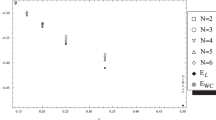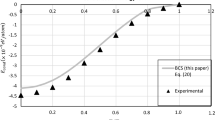Abstract
Using the microscopic formalism of Eilenberger equations, a three-band Ginzburg-Landau theory for the intraband dirty limit and clean interband scattering case is derived. Within the framework of this three-band Ginzburg-Landau theory, expressions for the critical temperature T c and the temperature dependence of the upper critical field H c2 are obtained. Based on some special cases of the matrix of interaction constants, we demonstrate the influence of the sign of the interband interaction on the critical temperature and the upper critical field as compared with a two-band superconductor where it plays no role. We study also analytically and numerically the effect of its magnitude.





Similar content being viewed by others
References
Y. Kamihara, T. Watanabe, M. Hirano, H. Hosono, J. Am. Chem. Soc. 130, 3296 (2008)
M. Tortello, D. Daghero, G.A. Ummarino, V.A. Stepanov, J. Jiang, J.D. Weiss, E.E. Hellstrom, R.S. Gonnelli, Phys. Rev. Lett. 105, 237002 (2010)
S. Johnston et al. unpublished
P. Cudazzo, G. Profeta, A. Sanna, A. Floris, A. Continenza, S. Massidda, E.K.U. Gross, Phys. Rev. Lett. 100, 257001 (2008)
M.J. Rice, Philos. Mag. B 65, 1419 (1992)
M.J. Rice, H.-Y. Choi, Y.R. Wang, Phys. Rev. B 44, 10414 (1991)
Q.H. Wang, C. Platt, Y. Yang, F.C. Zhang, W. Hanke, T.M. Rice, R. Thomale. arXiv:1305.2317v1
J. Garaud, J. Carlström, E. Babaev, Phys. Rev. Lett. 10(7), 197001 (2011)
S.-Z. Lin, X. Hu, New J. Phys. 14, 063021 (2012)
J. Garaud, J. Carlström, E. Babaev, M. Speight, Phys. Rev. B 87, 014507 (2013)
L. Komendová, Y. Chen, A.A. Shanenko, M.V. Milošević, F.M. Peeters, Phys. Rev. Lett. 108, 207002 (2012)
S.V. Shulga, S.-L. Drechsler, J. Low Temp. Phys. 129, 93 (2002)
S.V. Shulga, S.-L. Drechsler, G. Fuchs, K.-H. Müller, K. Winzer, M. Heinecke, K. Krug, Phys. Rev. Lett. 80, 1730 (1998)
H. Doh, M. Sigrist, B.K. Cho, S.L. Lee, Phys. Rev. Lett. 83, 5350 (1999)
I.N. Askerzade, A. Gencer, N. Guclu, A. Kihc, Supercond. Sci. Technol. 15, L13 (2002)
A. Gurevich, Phys. Rev. B 67, 184515 (2003)
A.A. Golubov, A.E. Koshelev, Phys. Rev. B 68, 104503 (2003)
M. Mansor, J.P. Carbotte, Phys. Rev. B 72, 024538 (2005)
I.N. Askerzade, JETP Lett. 81, 583 (2005)
P. Udomsamuthirun, A. Changjan, C. Kumvongsa, S. Yoksan, Physica C 433, 62 (2006)
A. Gurevich, Physica C 456, 160 (2007)
L. Min-Zia, G. ZiZhao, Chin. Phys. 16, 826 (2007)
A. Changjana, P. Udomsamuthiruna, Solid State Commun. 151, 988 (2011)
Y.Y. Tanaka, I. Hase, K. Yamaji, J. Phys. Soc. Jpn. 81, 024712 (2012)
R.G. Dias, A.M. Marques, Supercond. Sci. Technol. 24, 085009 (2011)
V. Stanev, Z. Tešanović, Phys. Rev. B 81, 134522 (2010)
V. Stanev, Phys. Rev. B 85, 174520 (2012)
S.-Z. Lin, X. Hu, Phys. Rev. Lett. 108, 177005 (2012)
M. Nitta, M. Eto, T. Fujimori, K. Ohashi, J. Phys. Soc. Jpn. 81, 084711 (2012)
T.K. Ng, Phys. Rev. Lett. 103, 236402 (2009)
V. Stanev, A.E. Koshelev. arXiv:1306.4268v1
K.D. Usadel, Phys. Rev. Lett. 25, 507 (1970)
A.V. Svidzinski, Space-Inhomogeneous Problems in the Theory of Superconductivity (Nauka, Moscow, 1982)
A.A. Shanenko, M.V. Milošević, F.M. Peeters, A.V. Vagov, Phys. Rev. Lett. 106, 047005 (2011)
A. Vagov, A.A. Shanenko, M.V. Milošević, V.M. Axt, F.M. Peeters, Phys. Rev. B 86, 144514 (2012)
N.V. Orlova, A.A. Shanenko, M.V. Milošević, F.M. Peeters, A.V. Vagov, V.M. Axt, Phys. Rev. B 87, 134510 (2013)
Acknowledgement
We thank the German-Ukrainian project for financial support. Discussions with D. Efremov, B. Holzapfel, Jeroen van den Brink, and A. Omelyanchouk are kindly acknowledged. Y.Y. thanks the IFW-Dresden for hospitality where the present work has been performed.
Author information
Authors and Affiliations
Corresponding author
Appendices
Appendix A: Derivation of Ginzburg-Landau Equations
For the anomalous Green functions f i we get:
Substituting f i into the self-consistency Eqs. (4) after the summation over the Matsubara frequencies we have finally
In order to obtain the GL equations, we multiply the first equation by λ 22 λ 33−λ 23 λ 32, the second equation by −(λ 12 λ 33−λ 13 λ 32) and the third equation by λ 12 λ 23−λ 13 λ 22. Then we sum these three expressions over Matsubara frequencies and finally obtain the GL equations (6) for Δ 1, Δ 2, and Δ 3.
Appendix B: The Determination of the Critical Temperature
T c can be found from the linearization of the GL system (6):
which leads to the cubic equation:
or using the phenomenological constants γ ij introduced in the main paper:
Equation (B.3) can be rewritten as:
Comparing Eq. (B.3) with the general form of a cubic equation and bearing in mind the representation of the coefficients a i and γ ij , we get
where
Depending on the sign of the discriminant Z=18BCD−4B 3 D+B 2 C 2−4C 3−27D 2 we have three distinct real roots, if Z>0, one real root and two complex conjugate roots, if Z<0 and three real roots, if Z=0.
If we expand the coefficients B, C and D in terms of the coupling constants λ ij and simplify the obtained expressions, we reveal that Eq. (B.5) for determination of the critical temperature is equivalent to the secular equation for the coupling matrix (7).
Appendix C: The Curvature of the Upper Critical Field
In the case (i) the upper critical field is determined by the equation:
where
Let’s consider the simple case when d 12=d 13=d and \(a = \frac{k_{0} + k_{1}}{k_{0}^{2} + k_{0}k_{1} - 2k_{1}^{2}}\), \(\tilde{\gamma} = \frac{k_{1}}{k_{0}^{2} + k_{0}k_{1} - 2k_{1}^{2}}\) and \(\eta_{a} = 1 + \frac{1}{k_{0} + 2k_{1}}\) (attractive interband interaction).
Then the second derivative yields
After further simplifications we obtain
Analogously it can be shown for repulsive interband interactions, that \(\frac{d^{2}h_{c2}}{dt^{2}}\) is non-negative, too.
Rights and permissions
About this article
Cite this article
Yerin, Y., Drechsler, SL. & Fuchs, G. Ginzburg-Landau Analysis of the Critical Temperature and the Upper Critical Field for Three-Band Superconductors. J Low Temp Phys 173, 247–263 (2013). https://doi.org/10.1007/s10909-013-0903-9
Received:
Accepted:
Published:
Issue Date:
DOI: https://doi.org/10.1007/s10909-013-0903-9




